Born on April 20, 1889, Adolf Hitler was the leader of Germany’s Nazi Party. He became the chancellor of Germany in 1933, adopted the title of Führer (“Leader”) in 1934, and attained dictatorial powers through the Enabling act.
He was referred to as the rebellious and ambitious leader. Hitler was regarded as the draft for World War 2 with an intense desire for territorial expansion.
He rose to power with the plan to colonize central and eastern Europe. Had he been successful, genocide and ethnic cleansing would have been dragged on a gigantic scale.
Hitler’s antisemitism led to tragic bloodshed. The Nazi troops killed 11 million people, including 6 million Jews and 5 million non-Jews. While working as a painter in Vienna, the hatred towards Jews prospered within him.
In 1945, Hitler, one of history’s most ruthless dictators, committed suicide in his bunker by swallowing a cyanide capsule. His beloved wife Eva Braun also died on the same day.
What was Holocaust?
Content
Holocaust was the mass slaughter of European Jews by German Nazis between 1941-1945.
Was Hitler a vegetarian?
Adolf Hitler suffered from flatulence, so he occasionally adopted a vegetarian diet. But his primary diet contained meat.
Why did Hitler take opiates?
He was prescribed opiates known as Dolatine by his doctor Theo Morell for instant recovery before wars.
10. Adolf Hitler was Austrian

Born in Braunau am Inn, an Upper- Austrian town, Adolf Hitler moved to Linz early. It remained his beloved city where he returned in 1938, on his way to Vienna, after the annexation of Austria to Germany.
He moved to Vienna around 1908 as he always wanted to become a painter. However, he was turned down twice by the Academy of Fine Arts.
The academy considered his drawing skills unsatisfactory, and frustrated, he pushed himself into politics.
In 1913, he finally moved to Munich, Germany, where he served in the Bavarian Army during World War 2 and participated in the First battle of Ypres.
Hitler renounced his Austrian citizenship in 1925. He remained without any nationality between 1925-1932.
A Nazi party member appointed him to a low-level government job with automatic citizenship.
Finally, he was granted German citizenship on February 23, 1932.
9. Adolf Hitler was nominated for the Nobel Peace Prize

Adolf Hitler was nominated for the Nobel Peace Prize in 1939. The Swedish parliament suggested Neville Chamberlain, the then British prime minister, as a nominee.
Chamberlain protected world peace by signing the Munich agreement with Hitler in 1938.
Erik Bandt, a social democrat and a member of the Swedish parliament, proposed Hitler be nominated too. Brant’s decision created a huge fuss among social democrats, liberals, and anti-fascists.
An enormous wave of denial arose, so his clubs and associations’ lectures had to be canceled. Later, Brandt explained his action. He stated that Hitler’s nomination was never intended to be serious.
Instead, it was a satirical criticism, so he withdrew the nominations on February 1, 1939.
8. Adolf Hitler advocated for animal rights
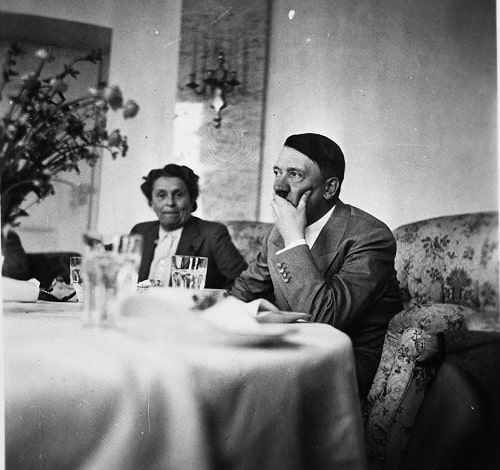
Adolf Hitler was considerate towards animals. He was against hunting and adored dogs. The Nazis also passed laws in opposition to animal slaughter in 1933.
The Nazi propaganda also used wild wolf images before taking power. Hitler owned a German shepherd dog named Blondi, who had been with him till his death. Hitler adored wolves too.
His headquarters in world war 2 were Wolf’s Canyon and Wolf’s Lair. Despite being the architect of the massive Holocaust, it is strange that he cared for animals.
Hitler banned all vegetarian organizations in Germany.
He even shut down the major vegetarian magazine in German territories. However, vegetarian diets would have helped them to alleviate wartime food shortages.
7. Adolf Hitler initiated the idea for the Volkswagen Beetle
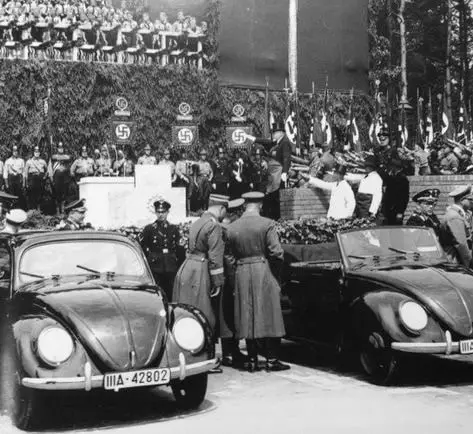
The best-selling car of all time, the Volkswagen Beetle, was designed under the control of Adolf Hitler in 1973. It was known as “the People’s Car.” Hitler’s pet project was to develop a speedy yet affordable automobile.
He had estimated the total cost to be less than 1,000 Reich marks (about $140 at the time). He hired an Austrian engineer Ferdinand Porsche for the completion of the task.
Just before the production of cars began, world war 2 started. The war halted Volkswagen’s manufacturing process. After the war ended, Germany could not initiate production as its factories were ruined.
The bomb-damaged Volkswagen was shipped to England around 1945. It was considered a noisy and unattractive car that showed no gain in business perspective.
Thus, the car was sold in the United States in an advertising campaign in 1959. Beetles were reconstructed and became the best-selling foreign-made car in America.
It surpassed Ford Motor Company’s highest production record.
People were fascinated by the fact that Hitler drafted the idea of Volkswagen, so the car reached heights of global success.
6. Adolf Hitler survived only on one testicle
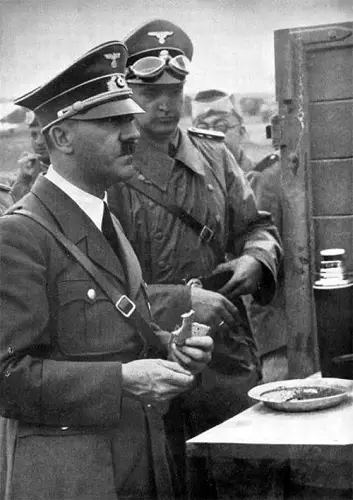
Adolf Hitler suffered from numerous health issues, one of which was “right-side cryptorchidism,” or a right undescended testicle.
It is a condition where a testicle has not moved to its proper position below the scrotum in the bag of skin even before birth. It was verified during a medical examination when Hitler was arrested for the Beer Hall Putsch in 1923.
The recorded evidence was thought to have been lost but reappeared at an auction in 2010. During world war 2, British troops referred to him as the “one who has only got one ball .”
They sang it to defame and intimidate the Nazi troops, “Hitler has only got one ball. Goring has two but is very small. Himmler has something similar. But poor old Goebbels has no balls at all.”
Hitler felt uneasy, so he often refused to undress for medical examinations as he did not want the world to know about his medical status.
5. Adolf Hitler admired Martin Luther

Martin Luther was a German monk and theologist. He was an early German nationalist better known for the German translation of the Holy Bible.
Martin sympathized with the Jews and believed that church corruption diverged them from Christianity. However, after he reformed Christianity, the Jews still did not give up their religion.
Luther then got furious, and he ordered them to be called upon for every form of harassment, suffering, and abuse. During Hitler’s stay in the men’s hostel, he despised the Germanophobia of the Catholic church.
He believed that Catholic churches had spilled more blood than any other religion. But he adored Martin Luther, who was a German friar. Just like Martin Luther, Adolf Hitler was an anti-semitic too.
Thus, it is likely that he admired Martin Luther. The feeling of extreme nationalism also linked them. The Nazi propaganda depicted Martin Luther’s teachings, pointing to Hitler’s liking toward Martin.
4. Adolf Hitler orchestrated the anti-smoking movement
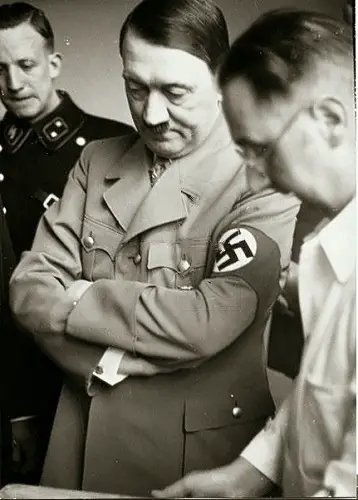
The German anti-tobacco movement was the most influential movement between 1930-1940 started under German chancellor Adolf Hitler’s regime.
One of the reasons for his full-fledged campaign’s support was his distaste for tobacco. His campaign included bans on smoking in public places and limiting cigarette rations. He even imposed heavy taxes on tobacco.
The Nazi regime inaugurated one of the most extensive and successful cancer prevention programs, which for the very first time proved the link between smoking and lung cancer in Germany in 1939.
Hitler even ordered the conduction of research on the disadvantages of smoking. He made rules and regulations to protect non-smokers, known as Nichtraucherschutz.
The Nazis deemed tobacco “genetic poison” because they feared smoking would corrupt the German germplasm. Hitler’s campaign was not perceived well by people during its initial days.
However, from 1940-to 1944, 23.4% of the German population ceased smoking. After the Nazi downfall and the end of world war 2, tobacco use peaked again.
3. Adolf Hitler as Times magazine’s “Man of the Year”
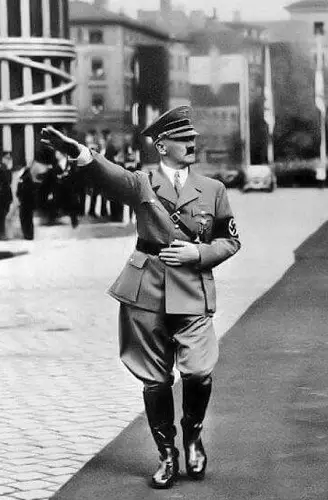
Adolf Hitler was listed as the “Man of the Year” by Times magazine on January 2, 1939. Times described him as the symbol of evil and the most threatening power that dismayed the democratic world.
Hitler’s actions left millions of civilized men and women traumatized. He tarnished the Versailles treaty into shreds.
The title was awarded only based on his influence that year, which had a destructive impact on the world.
He was talked about but only for his ill actions. In an utmost desire to appease his imperialistic ambitions, Hilter launched world war 2. Hitler’s ideologies attacked civil rights and liberties.
He annexed Austria and Sudetenland for territorial expansion. In addition to it, anti-democratic policies were also practiced by Hitler. His aggression left Europe in terror and hardly received any warm appraisal for the title.
2. Adolf Hitler was originally Schicklgruber
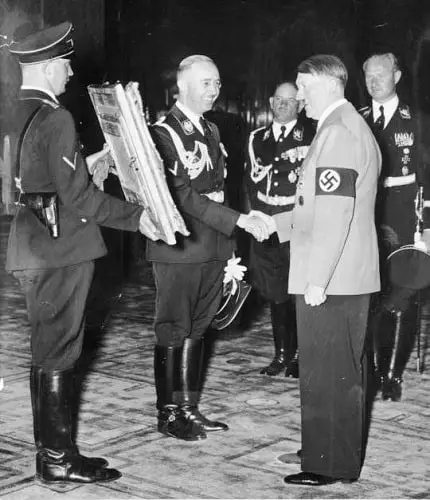
Adolf Hitler was the son of Alois Hiedler or Hitler. Alois was born to unmarried Maria Anna Schicklgruber, so he was Alois Schicklgruber. She later married Johann Georg Hiedler; however, the marriage lasted only five years until she died of natural causes.
Alois had used his mother’s last name Schicklgruber. He did not deny to state that he was an illegitimate child as such practices were prevalent at that time. But his uncle advised him to change his last name.
Hence, Alois adopted his step-father’s surname. Although his biological father was unknown, Alois was granted “Hitler” as a surname on legal documents. Hence, Adolf Hitler was considered Schicklgrubber who had a Schicklgruber ancestor.
1. Adolf Hitler never visited concentration camps
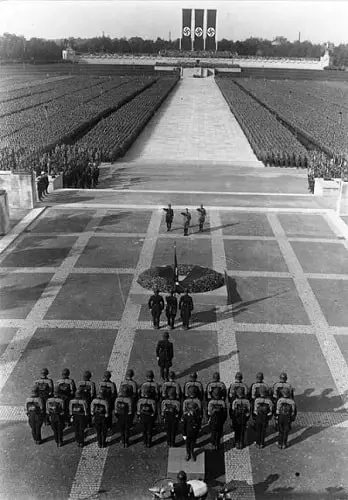
Hitler, who led to tragic Jew bloodshed, never set his foot in any concentration camps. The first extermination camp was formed in 1933, immediately after Hitler became the chancellor of Germany.
The main camps were Poland, Auschwitz, Belzec, Sobibor, Treblinka, etc. Chelmno was the first camp where gas chambers started. Similarly, Majdanek and Auschwitz were slave-labor centers.
Hitler was driven by anti-Semitic ideology, believing every form of abuse could call upon Jews. Thus, he built concentration camps.
The camps were designated to become the most inhospitable and brutal places on earth.
The Nazis enslaved about 11 million Jews and other racially undesirable people. They had to endure extreme torture; for instance, they were gassed to death in suffocating gas chambers.
The Nazi leader preferred to remain detached from the extermination centers because he did not want to face the brutal reality of camps. He used to pull down the curtains of his Fuhrer trains whenever a train carrying Jews passed by.
Hitler neither liked the camps nor felt the necessity to visit them. He ranked those places of no political value, but he regularly sent reports of the centers’ tasks.
Conclusion
To sum up, Adolf Hitler was regarded as one of the most influential men, although he violated human rights by sweeping European Jews. Likewise, he did not refrain from getting into anti-democratic and anti-Semitic activities.
He blamed a specific group of people for national issues as scapegoats and harbored unacceptable racial ideology in his troops.
Despite all the flaws, he was a man with incredible leadership skills whose convictions appealed to his admirers.
The Nazi and neo-Nazi troops adored him, so they owned special editions of Hitler’s “Mein Kampf” as a symbol of homage.
Hitler said that a decision once made should never be looked back on with remorse. His actions indeed stuck to his words.
